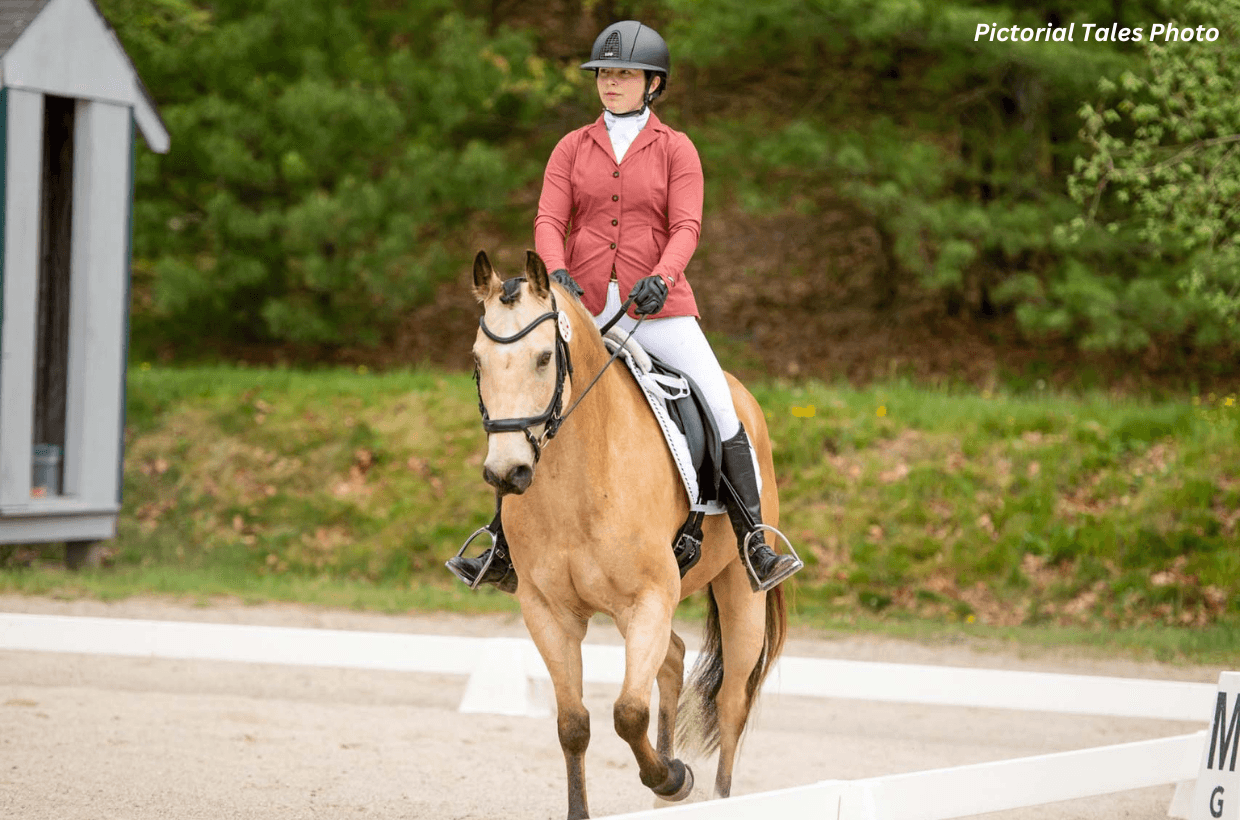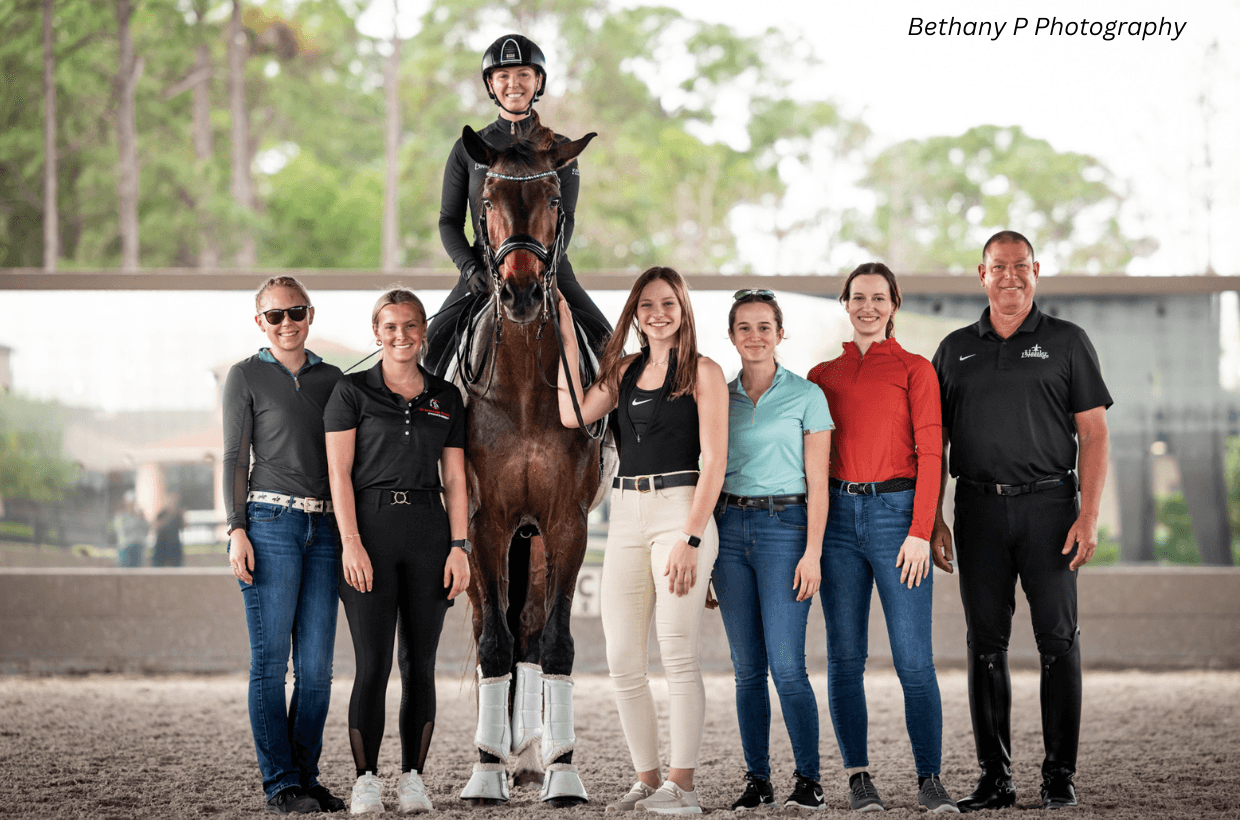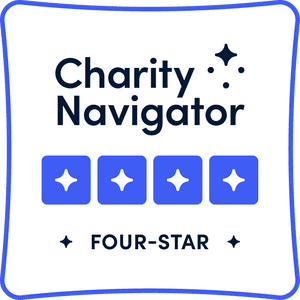Gifted Memorial Fund for Adult Amateurs Recipient: Kelly Steele (Region 2)
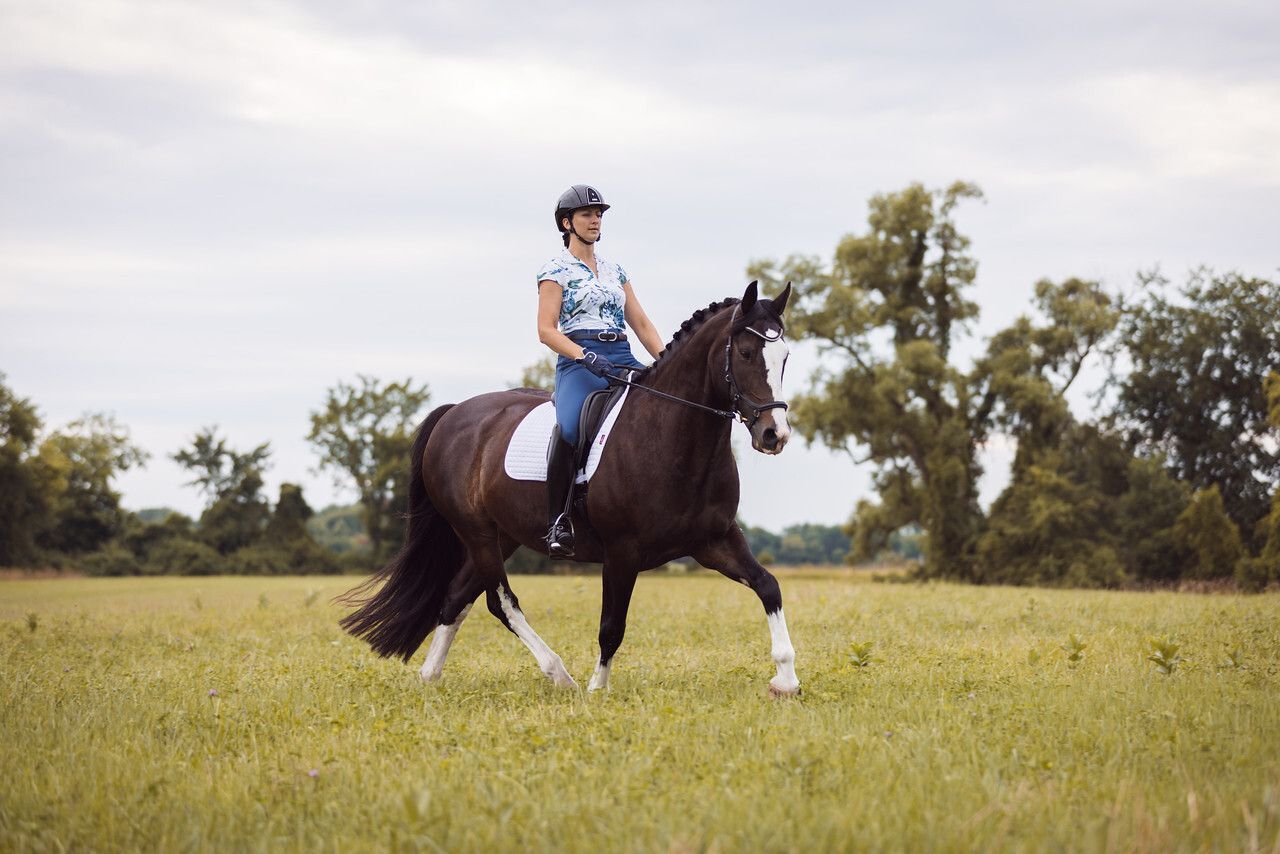
Working to get my USDF bronze medal has been a journey; a long, sweaty, dirty one filled with laughter during the high times and tears during the lows. I wouldn’t trade the path I have taken for an easier one. I have learned so much about horsemanship and grown so much as a rider and as a person. I have developed an amazing bond with a 1,400-pound animal that trusts me to get on her back each day.
I started leasing Chanel in the fall of 2011, but when life happened, I got married and moved out of state in the spring of 2013, and I gave up my full lease. I was able to ride her once a week if I was lucky. In December 2016 her owner reached out to see if I would want to take her on full-time and move her from Michigan to my new home state of Indiana. I did not even have to think twice about it.
11 years ago, Chanel was a solid Training Level horse and when I moved in 2013, we were pretty solid at First Level and had just started schooling Second Level movements. When I picked her up on December 31st, 2016, I decided that my goal with her would be to achieve my bronze medal and I was going to do it by the time I was 35. We had scores from 2013, before I moved, at First Level, so four scores were still needed. We worked hard to get back to where we were in 2013 (when I moved away) and spent the season hauling up to Michigan for lessons and shows at First and Second Level with the GMO, All Dressage Association, which I am a member of. We had a great season; we were Champion for First and Second Levels at the All Dressage Association year-end awards for their schooling show series.
Second Level proved to be much more of a challenge, our first try resulted in heartbreak but since that 2018 attempt, I have really learned to appreciate the small victories. Chanel appreciates it too.
We started dabbling with flying changes in 2019, a little earlier than planned, but I happen to have Chanel in Michigan for a few weeks where Laurie Moore taught, and it just made sense to see what we could do. In the end, she wasn’t ready, so we put those plans on hold and continued to work on the basics and building blocks to the changes, simple changes, quality of the canter, and connection.
In 2021, I spent most of the show season hauling to each show to school with Laurie Moore and working on the changes. I was able to wrap up my Second Level medal scores and achieved Chanel's and my personal best score as a team. These trips to shows for four days of lessons made sense because I was already working at the shows as a groom, my only extra cost was her stall. I really wanted to be able to spend dedicated time with Laurie. With Chanel turning 17 this year I knew it was now or never and applied for TDF's Gifted Memorial Fund for Adult Amateurs. I’m pretty sure my neighbors heard the screaming when I received the email that I had been awarded one of the grants.
Our original plan was to do eight days and seven nights in Grand Rapids, Michigan, with Laurie Moore; seven lessons on my mare Chanel and three lessons on a horse confirmed in the changes. April would be a perfect time to get a stall because the winter borders would leave, and I could sneak in before the Florida horses returned. I would be all ready to hit the ground running for the early shows and get my bronze medal.
Then it happened. I received a call that my good friend’s horse was down in the arena and couldn’t get up. She was out of the country, and I was the emergency contact. The next thing I knew the facility was quarantined, we had EHV that was developing into EHM. My dear friend's horse was so sick, my horse could be next. Chanel remained healthy, which I am thankful for every day. Going through something like that where you may not only never get to ride your horse again but even lose them really emphasizes how important it is to just get out there and do what you love, don’t wait. I couldn’t ride for six weeks while we were quarantined, a small price to pay compared to my friends who lost horses.
I gave Chanel six weeks to get back into shape after quarantine and was headed off to Grand Rapids. We decided to do our training as more of a boot camp style, ending with a few trips down the centerline. My original plan had to be tailored, I was only able to do one lesson on a horse with confirmed changes, but that one lesson paid off. I was able to fit 11 lessons in with Chanel, opting to stay with a friend and eat home-cooked meals in order to get more lessons. I was also able to watch Laurie teach most days, including a few other students working on the same things as me! Our goal was to get the flying change to a place where it was reliable and clean so that I could go out and get my bronze medal with Chanel.
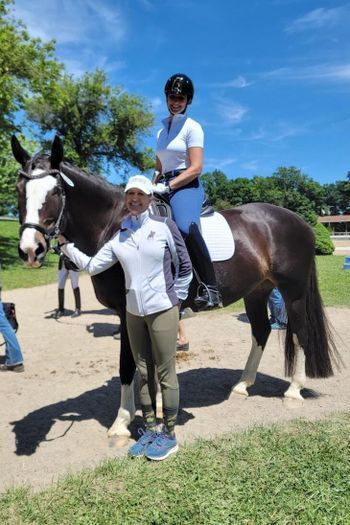
Day 1 – Connection. This is Chanel’s struggle on the dressage pyramid. One exercise that worked extremely well for us was to canter a 10-meter circle at M, transition to trot the last stride, and go right into shoulder-in. Chanel struggles with the bend in the trot but something about the canter just makes more sense. This helped us bridge that gap, maintaining connection, in the shoulder-in. In the flying changes to the left, she can get too hollow and to the right she has a hard time bending. Working on the exercises in the trot help with both the straightness and bending needed in the change.
Day 2 – Looseness. In the canter think long and reaching, feel that she is pushing the saddle up into your seat instead of your seat pushing down into the saddle. All collected work must be done out of looseness, not tension. In the warmup, we did lots of leg yielding to really get her into the outside rein and loose. From that exercise, we graduated to C to B leg yield, B 10-meter circle, and B to F shoulder-in. In the flying change from right to left she can get stuck, so the long-reaching forward canter is important to help her make that change.
Day 3 – Half Halts. Still struggling with some connection issues so Laurie suggested switching to the snaffle. Everyone was much happier after this change was made. Laurie had me do trot-walk-trot transitions then trot-almost walk-trot transitions to really feel where my half halts needed to be for both the half passes and flying changes. I have a tendency to grab and then drop my right rein, so we worked on me using it more in a vibrating type aid. Laurie gave me the challenge to do less work and let Chanel do more.
Day 4 – The Canter. Day four was all about the canter. Use the 10-meter circle to increase thoroughness (now I know I do not ride enough 10-meter circles at home). Since she is still green to the change do short diagonals, since long diagonals are much harder for the horse. To the change going forward and straight, yielding off the current outside rein and leg (new inside rein/leg). To complete the change she needs energy, feel her pushing the saddle to your seat bones. If she gets above the bit do a 10-meter circle right away on the current lead and try again once she is through. The heels must be down, if the heels are not down the seat bones cannot be on.
Day 5 – Stay on the Line. First, you must develop the swing in the warmup, then make her small; shorter in the back (not the neck) and out to the bit. You must have control of the shoulder when turning onto your line. Always the short line, for now. Stay on the line, half halt, and change. For now, she needs to be forward with her neck a little lower to the change. When she gets her neck up, she impedes herself from being able to make the change. After the change right away supple in the new direction.
Day 6 – Right Rein. Always be suppling on the right rein, both directions. That is the rein she struggles on, over flexing in the neck to the left and counter flexing to the right. Translating that to the change, from left to right she can stay round and collect and do the change easier, she is much straighter to the left. The right to left change is more about the forward pushing power, she gets stuck so ride with a slightly longer frame and the neck a little lower. Use the counter canter liberally in the warmup so she realizes that every diagonal line is not a flying change, especially left to right where she wants to steal the change.
Day 6 – Santo. Bonus ride. Santo forced me to straightness in the flying changes and struggles with right bend very similar to Chanel. The changes must be straight into the change and then immediately supple in the new direction (or on Santo a bonus change back might happen). Right to the left he will want to change back so you cannot give away that right rein (as I tend to do on Chanel frequently). Sit tall with heels down and seat bones on. The horse must have room to collect up, sit tall, and make room. Hands always need to be seeking where the horse is going, pushing the ride forward instead of holding the right back or riding front to back. Consistency in the contact comes from the stability of the rider and is completed by the horse. You should always feel you can let the reins out and they will seek the contact.
Day 7 – Position. After riding Santo, I had a good idea of the feeling I needed to create on day seven. We did a lot of work on my position. The first item was keeping them forward and pushing the contact forward verse my hands in my lap with my reins too long. The aids need to be small, with my arms forward and reins shorter I was able to give much smaller clearer aids. Toes must be up and seat bones on, sitting tall to give her back somewhere to go. The more stable and consistent I was the better and better Chanel got. We also spent time in downward transitions, making sure they were forward and through the outside rein, not from the hand but from the seat.
Day 8 – The Flying Changes. In the left, to right flying change she is very willing so just continues to think and tell her left canter, left canter, left canter until the change then just allowing the change. Since the right lead is the stiff lead really getting her supple on the right immediately helps the quality of the canter. In the right to left change, we continued to push forward with her neck low. She can anticipate it this way and throws her head up, then she isn’t able to change behind. In the 10-meter circle to the change right to left use the whip to tap like a metronome so she stays in rhythm and doesn’t lose impulsion.
Day 9 – Show Prep. She must be already established in the outside rein before asking for the shoulder-in. If the inside leg to outside rein is established, then all that needs to be done to shoulder-in is to move the hands in and stay inside leg to outside rein. Use the corners like 10-meter circles to re-establish the lost connection. In the changes, again reinforcing that the left to right think that we will counter canter then release to the change. Going to the right, forward, and downward with the neck. Keep the hands still and sit tall. We rode through 3-3 for the first time. We needed to determine which test would be the easiest for Chanel. The change in 3-3 is just across the short diagonal where in 3-1 there is a 10-meter circle immediately before the short diagonal that sometimes backs her off too much in the right to left change. In the end, we decided 3-1 is the way to go since she is so green to the level.
Day 10 – Counter Canter. Today we did lots of counter canter in the warm-up to ensure she is waiting for my aid in the change and not making the change, especially left to right. Each day we are having more and more of the changes clean. When she loses the connection and drops her back the neck needs to be lowered to get her back up. In the turn on the haunches, lift the outside seat bone to ensure the inside seat bone is on. In the canter continue to work on straightness, she is very haunches in to the left but straightening too abruptly will cause her to give a flying change. This process will need to be worked on gradually over time to get the shoulder forefeeling. Take the time to develop this so she understands the difference.
Day 11 – Transitions. On the final day, we spent more time on all the transitions. The walk-trot-walk transition with only one or two steps of walk, or even almost walk, helps refine the half halt. In this exercise, she must really tuck her pelvis and rebalance, which is the goal of the half halt. Remember that the contact is never backward, the hands must always give forwards. In the right to left change, she cannot feel trapped, ride it forward and give the hands forward, especially when asking. Left to the right continue to think counter canter. She must wait for the aid.
To summarize, the theme of the boot camp was maintaining the connection while riding a straighter horse to the left and a greater bend to the right. The change from left to right is much easier for Chanel so in that change she needs to be round and supple, but always thinking that we will stay in left lead canter, so she does not steal the change but rather waits for my aid. From right to left is a little harder for her, in that direction she must go with her neck slightly lower and have much more freedom to go forward so she does not feel trapped. She really relies on the rider to maintain consistency in the connection. Riding the horse confirmed in the changes, Santo, really helped me see how important my core stability is and really maintaining the feeling that my hands are always moving the bit to the next place the horse would be. Pulling back on Santo was not an option if you desired to continue moving forward, it was like riding with your emergency brake on in the car, you were not going to get far and definitely not fast.
Additionally, I was able to watch multiple lessons a day while Laurie taught. I am an extremely visual learner. It was wonderful to get to watch so many talented riders in the program and others that had similar struggles to Chanel and me. One thing I found very interesting is that there are so many ways to say the same thing and that is such an important thing as a coach to have the ability to communicate that in a way each unique student understands. One of these for me was that instead of thinking of the flying change as asking for the new canter lead, think of riding one lead and releasing to the new lead.
Now that I have done some rides at home on my own, I feel very confident in the changes. We have clean changes in both directions! Occasionally I am still getting extra changes, mainly if I straighten her too quickly in the left canter (especially medium or extended canter) or do not get her supple and on the new bend after a change. I also feel like my stability in the saddle and core strength have greatly improved with the focus we gave to how my position affects Chanel. She can get blocked, so riding Santo and reenforcing the constant giving in the hands really has helped me with the consistency in the contact and overall harmony of the ride.
The opportunity to spend so much time working with Laurie has changed the partnership between Chanel and me. We may not have finished the boot camp with a bronze medal, but we ended one score closer. 2022 is going to be our year and I can’t wait to continue this journey with Chanel.

